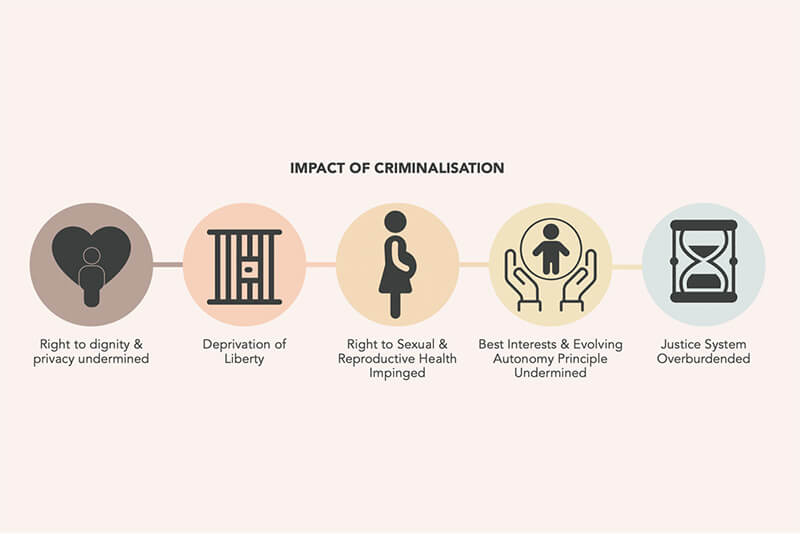
India enacted the Protection of Children from Sexual Offences Act (POCSO Act) in 2012 to plug the legislative gaps concerning sexual violence against children and prescribe childfriendly provisions during investigation and trial. This was influenced by civil society efforts, government data on child sexual abuse, exhortation for a legislation by the Supreme Court, as well as obligations under the Constitution and the United Nations Convention on the Rights of the Child, 1989 (UNCRC). The POCSO Act defines “child” to mean “any person below the age of eighteen years” and effectively increased the age of consent for sexual acts from 16 years to 18 years. With 253 million adolescents, India is home to the largest adolescent population in the world, and public health surveys indicate that a significant proportion of Indian teenagers are sexually active. According to the National Family Health Survey-5, 2019-21 (NFHS-5), 10% of women in the age group of 25-49 years had their first sexual intercourse before the age of 15, and 39% had their first sexual intercourse before the age of 18 years. The POCSO Act, however, does not recognise the possibility of consensual sexual activity among or with older adolescents above 16 years. A five-state study based on judgments of Special Courts under the POCSO Act revealed that “romantic” cases i.e. cases in which the victim admitted to a relationship with the accused, constituted 21.2% cases in Andhra Pradesh, 15.6% in Assam, 21.5% in Delhi, 21.8% in Karnataka (in 3 districts), and 20.5% of the decided cases in Maharashtra. A three-state study of “romantic cases” decided by Special Courts in Assam, Maharashtra and West Bengal, indicated that such cases constituted 24.3% of the total cases disposed between 2016-2020. In recent years, some High Courts have questioned whether the POCSO Act was enacted with the intention of regulating adolescent sexuality and have recommended legal reform. In Vijayalakshmi v. State Rep. the Inspector of Police, the Madras High Court observed that the use of the POCSO Act could lead to irreversible damage to the reputation and livelihood of youth whose actions were only a consequence of “biological attraction” and questioned the wisdom of criminalising such acts.
The criminalisation of adolescents and young people and their entanglement in the criminal justice and juvenile justice systems necessitates a review of the existing legislative framework. This policy brief unpacks the implications of 18 years as the age of consent on adolescents’ rights under domestic law and international human rights law and proposes a policy alternative that advances rights and strikes a balance between their protection and evolving autonomy. It draws upon legal standards, empirical studies, judicial precedents, as well as focus group discussions with Investigating Officers, and interviews with Child Welfare Committee Members, Juvenile Justice Board Magistrates and Members, Special Court Judges, lawyers, mental health experts, medical practitioners, public prosecutors, academicians, and NGOs working in the area of children’s rights….
Since the 19th century, age of consent laws have been marked by shifts in the understanding of childhood, adolescence and adulthood, fuelled by developments in women’s and child rights discourse, as well as multiple socio-cultural and political factors. The legislative provisions have been reflective of a colonial and patriarchal understanding of females as properties of their father or their husband.13 In India, the age of consent was blurred with the age of marriage, and social reformers often sought to increase the age of consent, with the explicit aim of raising the age of marriage….
In 2013, despite the recommendations by the Justice Verma Committee that the age of consent be reduced to 16 years, Section 375, IPC was amended, and the age of consent was increased to 18 years. Where two underage minors are involved in a sexual relationship, the Juvenile Justice (Care and Protection of Children) Act, 2015 is applicable with the possibility of a child above 16 years being tried as an adult for heinous offences….
In 2018, the marital rape exception in the IPC, as per which sexual intercourse by a man with his wife not below 15 years would not constitute rape, was read down by the Supreme Court of India for being unconstitutional and violative of the rights of children and the POCSO Act. Thus, although a child marriage is valid under personal law and the Prohibition of Child Marriage Act, 2006, except in certain circumstances, sex within such a marriage constitutes rape or aggravated penetrative sexual assault. In 2019, following gruesome incidents of sexual violence against children, the minimum punishment for penetrative sexual offences under the POCSO Act was enhanced, and the death penalty was introduced for aggravated penetrative sexual assault….
The lack of recognition of consensual sexual behaviour of older adolescents has resulted in their automatic criminalisation, as well as a conflation of consensual acts with non-consensual acts. While all children and adolescents are entitled to protection from sexual exploitation and violence, the approach adopted under the POCSO Act renders adolescents vulnerable to criminal prosecutions for normative sexual behaviour. This section examines the implications of such criminalisation on their right to dignity, personal liberty, privacy, health, and their best interests and the impact on the justice system….
The Constitutional Court of South Africa in Teddy Bear Clinic for Abused Children & Anr. v. Minister of Justice and Constitutional Development & Anr. has held that legal provisions criminalising consensual sex amongst adolescents offended their dignity, even if they are rarely enforced. It concluded that “[i]f one’s consensual sexual choices are not respected by society, but are criminalised, one’s innate sense of self-worth will inevitably be diminished.” Further, “the existence of a statutory provision that punishes forms of sexual expression that are developmentally normal degrades and inflicts a state of disgrace on adolescents.” In the Indian context, the blanket criminalisation of consensual sex among or with adolescents in gross oversight of their sexual development, bodily integrity and autonomy, and normal desires for attachments and relationships, undermines their fundamental right to life, privacy, and dignity….
While the ostensible objective may be to protect all children below 18 years from sexual exploitation, the law’s unintended effect has been the deprivation of liberty of young people in consensual relationships. Although convictions in “romantic” cases are an exception, the accused men and boys are predominantly charged with non-bailable offences such as rape and penetrative sexual assault and are inevitably taken into custody. As per an analysis based on judgments of three States, in 15.2% of romantic cases the accused remained in judicial custody till the end of the trial. In Rama @ Bande Rama v. State, the 20-year-old accused in a “romantic” case was in judicial custody for 18 months. While quashing the case, the Karnataka High Court observed that the criminal process itself inflicted pain on the parties and despite an acquittal, “the sword of crime would have torn the soul of the accused.” In stray cases, a strict view that the consent of a minor is irrelevant, coupled with the lack of sentencing discretion, has resulted in the imposition of high minimum mandatory sentences such as 10 years for engaging in consensual sex.38 With the amendment in 2019, such cases will attract a higher minimum sentence of 20 years if it is a case of repeated sex, or if it has resulted in a pregnancy….
The law also undermines the identity of adolescent girls by uni-dimensionally casting them as “victims”, rendering them voiceless, and without any agency to enter into relationships or choose their partners. Adolescent boys, on the other hand, are discriminatorily treated as children in conflict with the law and can even be tried as adults. The liberty of adolescent victim-girls is compromised as they are institutionalised in Children’s Homes when they refuse to return to their parents and insist on being with their partner. A study on their plight reveals that “they are shamed, humiliated, and stigmatised for their acts, alienated from their partners and society, and at times not released even after they turn 18. Such institutionalisation harms their physical and mental health, as well as overall development, and they have little or no recourse to challenge or seek review of such decisions.” Administrative confusion about whether the girls should be released by the court or Child Welfare Committees prolonged their detention even after many of them had attained majority. Girls who are pregnant or have given birth to a child are compelled to reside in a Children’s Home where access to sexual and reproductive health services and familial care is limited….
An analysis revealed that 80.2% of the complainants in “romantic” cases were parents and relatives of adolescent girls who registered a case after she eloped, or her pregnancy was discovered. Pointing to the possibility of further misuse of the POCSO Act, it showed that in 21.8% of romantic cases, the girls disputed the claim by their families that they were minors….
Studies explain that the primary reasons for girls leaving their homes were parental disapproval of the relationship, arrangement of a marriage against their will, unreasonable restrictions on their mobility and social life, and violence at home. Structural factors such as poverty, uneven development, discriminatory treatment of girls, and the lack of meaningful educational opportunities exacerbate the situation and prompt elopements in the hope of a better future….
The Medical Termination of Pregnancy Act, 1971 also requires authorisation by a guardian for termination of pregnancy of a minor, making it challenging for adolescents to seek these services confidentially. A Rapid Programme Review of Adolescent Reproductive and Sexual Health Program (ARSH) and RKSK by the WHO revealed that the mandatory reporting obligation and absence of an exception for consensual sexual relationships between minors, resulted in confusion among service providers who are “inclined to deny SRH services to young people in some states”….
Mandatory reporting combined with the lack of recognition of adolescent sexuality results in insurmountable barriers and a hostile environment for adolescents seeking confidential sexual and reproductive health services. The fear of their partner being reported to the police also deters girls from availing medical services from a professional and inadvertently pushes them towards unsafe abortions. Evidence shows that the “risk of death from an abortion related complication in India is highest in the case of underage girls (aged 15-19)”. It also affects adolescents who are in need of diagnostic tests to confirm pregnancy, STIs, or HIV status. The current legal regime also contravenes the CRC’s recommendation to India to “[t]ake measures to ensure that adolescent girls and boys have effective access to confidential sexual and reproductive health information and services such as modern contraception as well as girls’ access to legal abortions in practice….
Overall, the evidence categorically points to the consideration of social realities of teenage sexuality by Special Courts.
“Romantic” cases are overburdening an already-strained criminal justice system by consuming significant time of the judiciary, police, child protection system, forensic science laboratories, and medical practitioners. In 2021, for instance, 92.6% of POCSO cases were pending disposal by the courts. The futility of using criminal law to regulate adolescent sexuality is evinced by the abnormally high acquittal rates in such cases. An analysis reveals that only 11.4% of such cases were disposed of within a year of the FIR, while the large majority i.e., 60.7% cases took between one to four years to be disposed of. These cases have also consumed the time of the higher judiciary which has been flooded with appeals and petitions to quash criminal proceedings; habeas corpus petitions; bail applications; and petitions from couples seeking protection from their families in the context of romantic cases. Finally, the inclusion of factually consensual and non-exploitative acts involving adolescents is detracting from the purpose of the POCSO Act and is diverting time, resources, and energy away from the investigation and trial of actual cases of sexual violence and exploitation….
“Life is precious in itself. But life is worth living because of the freedoms which enable each individual to live life as it should be lived. The best decisions on how life should be lived are entrusted to the individual. They are continuously shaped by the social milieu in which individuals exist. The duty of the state is to safeguard the ability to take decisions – the autonomy of the individual – and not to dictate those decisions.”
[Justice D.Y.Chandrachud in Justice K.S.Puttaswamy v. Union of India, AIR 2017 SC 4161]
In the concluding section, the article calls for comprehensive sexuality education, resolving of the dichotomy between health programs and the legal regime, and decriminalization of adolescent sexuality.
TEXT & VISUAL: https://www.girlsnotbrides.org/documents/1960/POSCO-Act-Policy-Brief_wUlR95W.pdf



